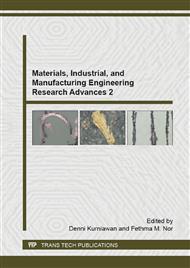[1]
M. Kouril, P. Bovak, and M. Bojko, Threshold Chloride Concentration for Stainless Steels Activation in Concrete Pore Solutions, Cement and Concrete Research, Vol. 40, 2010, pp.431-436.
DOI: 10.1016/j.cemconres.2009.11.005
Google Scholar
[2]
E. Redaelli, F. Lollini, and L. Bertolini, Throwing power of localized anodes for the cathodic protection of slender carbonated concrete elements in atmospheric conditions, Construction and Building Materials, Vol. 39, 2013, pp.95-104.
DOI: 10.1016/j.conbuildmat.2012.05.014
Google Scholar
[3]
C. Q. Li, and M. Mahmoodian, Risk based service life prediction of underground cast iron pipes subjected to corrosion, Reliability Engineering & System Safety, Vol. 119, 2013, pp.102-108.
DOI: 10.1016/j.ress.2013.05.013
Google Scholar
[4]
J. A. Jeong, C. K. Jin, Tidal water effect on the hybrid cathodic protection systems for marine concrete structures, Journal of Advanced Concrete Technology, Vol. 10, No. 12, 2012, pp.389-394.
DOI: 10.3151/jact.10.389
Google Scholar
[5]
M. H. Im, "Cavitation Characteristics on Impeller Materials of Centrifugal Pump for Ship in Sea Water and Fresh Water, Corrosion Science and Technology, Vol. 10, 2011, p.218.
Google Scholar
[6]
J.A. Jeong, C.K. Jin, The effect of temperature and relative humidity on concrete slab specimens with impressed current cathodic protection system, vol. 37, Korean Society of Marine Engineers, 2013, pp.260-265.
DOI: 10.5916/jkosme.2013.37.3.260
Google Scholar
[7]
T. D Rincon et al, Environmental Influence on Point Anodes Performance in Reinforced Concrete, Concrete and Building Material, Vol. 22, 2008, pp.494-503.
Google Scholar
[8]
Y.B. Ko, G. B, Kim, K.C. Park, Soundness evaluation of friction stir welded A2024 alloy by non-destructive test, vol. 37, Korean Society of Marine Engineers, 2013, pp.135-143.
DOI: 10.5916/jkosme.2013.37.2.135
Google Scholar
[9]
J.H. Jeong, Y.H. Kim, K.M. Moon, M.H. Lee, J. K Kim, Evaluation of the corrosion property on the welded zone of seawater pipe by A. C shielded metal arc welding, vol. 37, Korean Society of Marine Engineers, 2013, pp.877-885.
DOI: 10.5916/jkosme.2013.37.8.877
Google Scholar
[10]
S.J. Kim, S.J. Lee, S.O. Chong, Effect of cavitation for electrochemical characteristics in seawater for austenitic 304 stainless steel, vol. 37, Korean Society of Marine Engineers, 2013, pp.484-492.
DOI: 10.5916/jkosme.2013.37.5.484
Google Scholar
[11]
Rasheeduzzafar, M. G. Ali, Effect of Temperature on Cathodic Protection Criterion for Reinforced Concrete Structures, ACI Special Publications, Vol. 139, 1993, pp.21-40.
Google Scholar
[12]
F. Hunkeler, The Resistivity of Pore Water Solution - a Decisive Parameter of Rebar Corrosion and Repair Methods, Construction and Building Materials, Vol. 10, 1996, pp.381-389.
DOI: 10.1016/0950-0618(95)00029-1
Google Scholar
[13]
S.J. Kim, S.J. Lee, S.O. Chong, Effect of cavitation for electrochemical characteristics in seawater for austenitic 304 stainless steel, vol. 37, Korean Society of Marine Engineers, 2013, pp.484-492.
DOI: 10.5916/jkosme.2013.37.5.484
Google Scholar
[14]
ASTM C876-91, Annual Book of ASTM Standards, vol. 03. 02, (1994).
Google Scholar
[15]
J.A. Jeong, C.K. Jin, The effect of temperature and relative humidity on concrete slab specimens with impressed current cathodic protection system, vol. 37, Korean Society of Marine Engineers, 2013, pp.260-265.
DOI: 10.5916/jkosme.2013.37.3.260
Google Scholar
[16]
T, Pastore, P. Pedeferri, L. Bertolini, F. Bolzoni, Rehabilitation of Concrete Structures, vol. 4, 1992, p.189~200.
Google Scholar
[17]
F. J. Presuel-Moreno, S. C. Kranc, and A. A. Sagues, Corrosion Science, vol. 61, 2005, p.548.
Google Scholar


